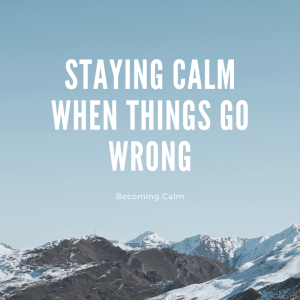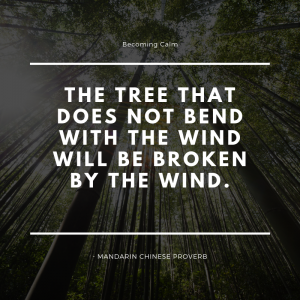
Staying Calm When Things Go Wrong
Staying Calm When Things Go Wrong
Skiing is my happy place day in and day out throughout the long Wisconsin winters. We ski multiple days a week and take a couple trips out west each year for mountain skiing.
We were in the mountains a few weeks ago and skiing our last run down a double black chute to end the week. If you don’t ski, picture a very steep slope with a narrow path down the middle and trees and rocks on both sides. You wouldn’t consider sledding down it because you would need the ability to stop at any point, especially near the curve at the bottom.
The Fall
As most athletes often do from time to time, I made a small miscalculation, lost my footing, and started to fall.
I tumbled down the chute like a rag doll. End over end.
I couldn’t stop myself. My first reaction was panic. I picked up speed as I tumbled down the chute and launched airborne whenever I hit bumps. One of the rather abrupt landings was on my head. The noise my head made on impact was frightening.
In that momemt, I also knew that this fall might not stop until I hit the trees on either side or near the curve at the bottom.
However, instead of going into full-blown panic mode, which was my first instinct, I reminded myself to relax, let my body go limp, and stop trying to fight the fall. Let happen what was going to happen. I even reminded myself that a calm and relaxed body would handle the impacts much better than a rigid and tense body.
Everytime my body made impact after I was launched in the air, I just kept trying to stay as relaxed as possible for the next impact.
I’m not going to lie, I thought I was going to die or be seriously injured as I fell. The hits to my head and knowing the probability of full speed impact with a tree was a lot to have to process during the fall.
According to my husband who watched the entire thing unfold from above, the fall lasted at least 30-60 seconds. I fell for about 800-1,000 feet. That’s a lot of time to have to think about what’s going on.
Considering that we usually have the ability to think of what feels like a million things in just a split second – having an entire half minute, maybe more, to think about what was happening was a very unwelcome feeling.
In what was an amazingly lucky break, I fell in a straight path down the entire chute and I finally slowed to a stop before veering off into the trees and just before the natural curve near the bottom.
I was overcome with relief that I stopped and I was okay. I could stand up and none of my lower body was hurt (including my knees, which usually take any injury in a ski fall). However, my face was numb and I could feel the swelling and bleeding. I immediately picked up the snow and began to ice my face to prevent further swelling as I got my bearings.
I knew I hit my head and I was able to do a quick self-assessment and tell myself I remained conscious throughout the fall, I knew where I was, and I didn’t feel nauseous.
Two other skiers who came across us collected all my belongings that scattered everywhere – my phone, my car keys, my ID, the lenses to my goggles, and more. As I tumbled, I fell so hard that my pockets unzipped themselves and emptied all the contents all over the snow.
The adrenaline in the first moments after I came to a stop even kept me focused on finding my ID as I knew I needed it to fly home the next morning.
When they reached me and took one look at my face, I could see the horror in their eyes. I reassured them about my assessment I’d just performed. When my husband reached me, I also spent some time calming him down, as he had feared the worst as he watched it happen.
After the Fall
The time between the fall and the emergency room was extended due to our location and my initial adrenaline-fueled response that I was OK. In fact, I signed a form with the ski patrol that I had a potential life-threatening injury, but was refusing further treatment. (I don’t know why I thought that was a good idea, but in the moment, since I didn’t hit the trees, I thought I had avoided serious injury).
However, the calmness I displayed during and immediately after the fall replaced itself with increasing worry about an internal injury.
It wasn’t until after the adrenaline completely wore off that my head and chest began to hurt. The pain in my neck wouldn’t even surface for a couple of days.
During that time I spent hours convincing myself I’d be ok, but also worrying what would happen if I wasn’t. Keeping myself calm and out of panic became increasingly difficult. I realized I needed to see a doctor sooner rather than later.
The first doctor I saw requested an immediate transfer to the emergency room. It got really hard to stay calm at that point.
The ER doctor ordered CT scans and chest x-rays to look for facial fractures, brain bleeds, a broken neck or ribs, and a punctured lung. After he named all the things he suspected, I was filled with worry on the inside. I reminded myself that if anything was wrong, being in the ER was the safest place to be. The most welcome news, the scans and x-rays showed none of the things they were looking for.
I walked away with only a terribly bruised face, an excruciating headache, and a stiff, sore neck. The relief was wonderful.
Becoming Calm
While I’m sure it was almost entirely due to luck (and my helmet) that I didn’t have any severe injuries, a small part of me wonders if my ability to keep my mind and body relaxed during the fall contributed in some positive way. The Chinese proverb that states the tree that does not bend with the wind will be broken by the wind – that saying applies to our mind and our body too.

The tree that does not bend with the wind will be broken by the wind.
I also had to practice a great deal of calming myself down in the time between the fall and seeing a doctor. I wanted to believe I was right and everything turned out ok, even though I didn’t go directly to the ER. It’s easy to tell myself it was the right decision since it all ended up ok. But if I’m honest, deep down I know it wasn’t the right decision and if anything had been wrong my decision to wait could have been catastrophic. My friends remind me of that poor decision making.
Hopefully, I learned something from my poor decision making. It’s hard to remember that when your brain is overcome with emotion, relief, adrenaline, stress and more that sometimes decision making isn’t the best. Tell yourself you did the best you could at the time with the information you had under the emotions you felt. It’s too easy to keep going over the details and what could have been done differently, but like most things, that’s not very helpful to heal.
A huge part of becoming calm isn’t practicing it only while things are going wrong. It’s practicing becoming calm regularly so it becomes a familiar habit and is available to you in a time of panic. I never could have relaxed my body during the fall if it wasn’t something I’d practiced as a daily habit. Learning about mindfulness and meditating was a quick reflex to put in place in a moment of panic.
I was proud of myself for remembering to try to calm myself with positive thoughts when the panic was deep and overwhelming. Each time I began to worry more, I kept trying to return to a calm state of mind over and over.
I also practiced telling myself that as soon as I saw the doctor and the results came back, I would have answers. Reminding yourself that the feeling of panic is temporary and will not last forever is helpful when you feel like things aren’t in your control.
Share Your Stories
In the time since the fall, I’ve dealt with some stress about getting overly anxious and protective, especially with the safety of my kids. My doctor mentioned that it’s a typical reaction. She also said it helps to tell people the story so it doesn’t cause you further stress.
Ironically, since I’d recently started Becoming Calm, I knew I had the perfect place to share my story.
Thanks for letting me share it with you. I’d love to hear your stories too. Both in times when you tried to stay calm and times when you couldn’t. In big moments and small moments. And everything in between.







0 Comments
6 Pingbacks